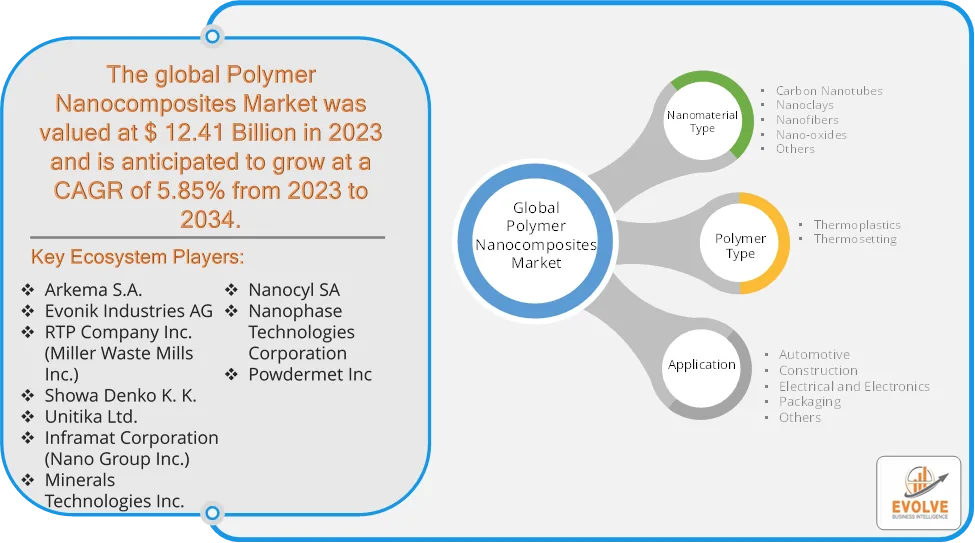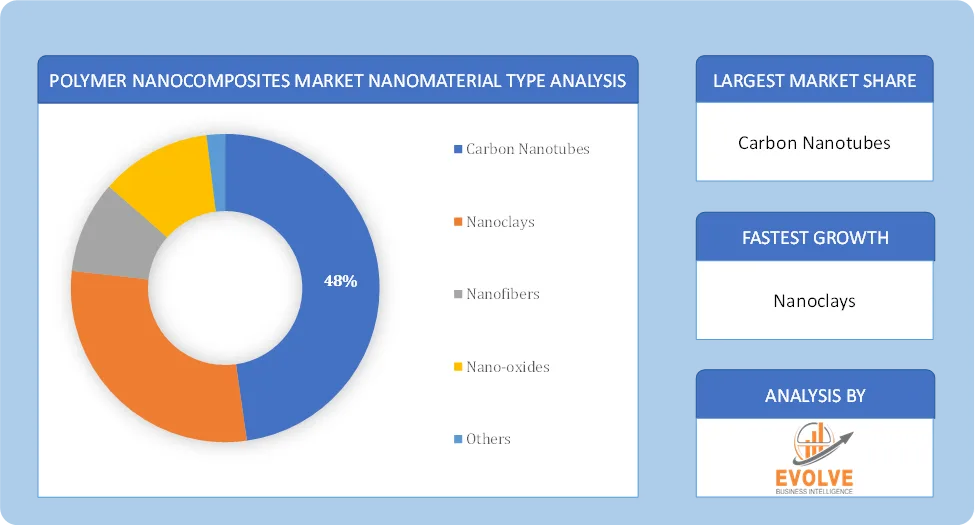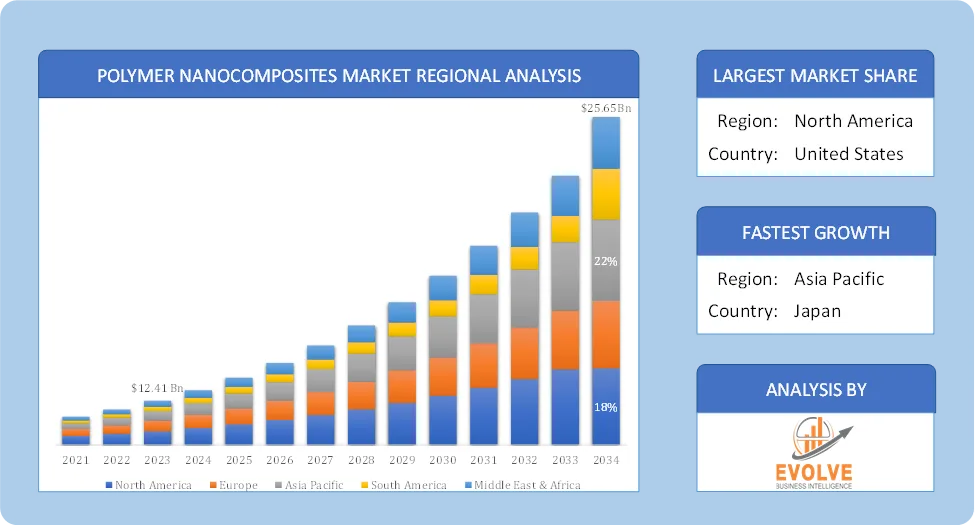Polymer Nanocomposites Market Analysis and Global Forecast 2024-2034
$ 1,390.00 – $ 5,520.00Price range: $ 1,390.00 through $ 5,520.00
Polymer Nanocomposites Market Research Report: Information By Nanomaterial Type (Carbon Nanotubes, Nanoclays, Nanofibers, Nano-oxides, and Others), Polymer Type (Thermoplastics, Thermosetting), Application (Automotive, Construction, Electrical and Electronics, Packaging, and Others), and by Region — Forecast till 2034
Page: 165
Polymer Nanocomposites Market Overview
The Polymer Nanocomposites Market size accounted for USD 12.41 Billion in 2023 and is estimated to account for 15.99 Billion in 2024. The Market is expected to reach USD 25.65 Billion by 2034 growing at a compound annual growth rate (CAGR) of 5.85% from 2024 to 2034. The Polymer Nanocomposites Market refers to the industry focused on polymer-based materials reinforced with nanometer-sized particles. These nanocomposites exhibit enhanced mechanical, thermal, and barrier properties compared to traditional polymers, making them valuable in various industrial applications.
The polymer nanocomposites market presents a dynamic and high-growth landscape, driven by the increasing demand for advanced materials across various industries. Continuous innovation, a focus on sustainability, and expanding applications are expected to fuel further market expansion.
Global Polymer Nanocomposites Market Synopsis
 Polymer Nanocomposites Market Dynamics
Polymer Nanocomposites Market Dynamics
The major factors that have impacted the growth of Polymer Nanocomposites Market are as follows:
Drivers:
Ø Rising Demand for Lightweight Materials in Automotive & Aerospace
The push for fuel efficiency and reduced carbon emissions has led to increased adoption of lightweight materials. Polymer nanocomposites replace heavier metal components, improving vehicle and aircraft performance while maintaining structural integrity and Continuous R&D efforts in nanotechnology have led to improved dispersion techniques and novel polymer nanocomposite formulations, expanding their usability in various industries. Conductive polymer nanocomposites are increasingly used in flexible electronics, sensors, and high-performance coatings, improving electrical conductivity and durability in next-generation electronic devices.
Restraint:
- High Production and Processing Costs
The complex manufacturing process and the need for specialized equipment increase production costs, making polymer nanocomposites more expensive than conventional polymers. Achieving uniform dispersion of nanoparticles within the polymer matrix is technically challenging, often requiring advanced processing techniques, which can limit large-scale production and the lack of standard guidelines for polymer nanocomposites, along with concerns about health and environmental impacts, has led to stringent regulations that could hinder market growth.
Opportunity:
⮚ Growth in the Electronics and Semiconductor Industry
Expanding applications in flexible electronics, wearable devices, and next-generation semiconductors offer significant potential for conductive polymer nanocomposites, improving durability and performance. The shift toward eco-friendly materials is driving the development of biodegradable nanocomposites, opening opportunities in packaging, healthcare, and consumer goods industries and polymer nanocomposites with antimicrobial, biocompatible, and drug delivery properties are gaining traction in medical implants, wound dressings, and regenerative medicine, creating new avenues for growth.
Polymer Nanocomposites Market Segment Overview
Based on Nanomaterial Type, the market is segmented based on Carbon Nanotubes, Nanoclays, Nanofibers, Nano-oxides, and Others. Nanoclay segment dominated the market. Primarily, nanoclay’s excellent mechanical, thermal, and barrier properties make the polymers reliable for several applications in packaging, automotive, and more. Its stiffness, fire resistance, and low gas permeability made it a versatile material to be used with different industrial applications. Besides that, the relative ease of its availability and cost-effectiveness when compared with other nanomaterials make it even more dominant in terms of market presence.
By Polymer Type
Based on Polymer Type, the market segment has been divided into Thermoplastics, Thermosetting. The Thermoplastics segment dominant the market.
By Application
Based on Application, the market segment has been divided into Automotive, Construction, Electrical and Electronics, Packaging, and Others. The automotive segment dominant the market. In order to significantly reduce weight and enhance the fuel efficiency of the car or aircraft system, polymer nanocomposite materials are primarily utilised to replace heavy metal composites in the automotive and aerospace industries. The product is used by the automobile industry to create tyres, pieces for cars including doors and fuel lubricants, and other under-the-hood elements
Global Polymer Nanocomposites Market Regional Analysis
Based on region, the global Polymer Nanocomposites Market has been divided into North America, Europe, Asia-Pacific, the Middle East & Africa, and Latin America. North America is projected to dominate the use of the Polymer Nanocomposites Market followed by the Asia-Pacific and Europe regions.
 North America Polymer Nanocomposites Market
North America Polymer Nanocomposites Market
North America holds a dominant position in the Polymer Nanocomposites Market. It’s driven by strong demand in automotive, aerospace, electronics, and healthcare industries. The U.S. dominates due to heavy investments in nanotechnology R&D and the presence of leading nanomaterial manufacturers. It has Strong government and private-sector funding for nanotechnology and increasing demand for nanocomposite-based packaging in the food and pharmaceutical sectors. Developments in the automotive and aerospace industries are further accelerating growth. Increasing government policies aimed at lowering carbon footprints are also pushing market development.
Asia-Pacific Polymer Nanocomposites Market
The Asia-Pacific region has indeed emerged as the fastest-growing market for the Polymer Nanocomposites Market industry. Asia-Pacific is the fastest-growing market for polymer nanocomposites, led by China, Japan, India, and South Korea. Rapid industrialization, urbanization, and infrastructure growth are driving demand in automotive, construction, and electronics. High demand for electronic devices and semiconductor materials, driving the need for polymer nanocomposites and growth of 3D printing and smart coatings in the manufacturing sector.
Competitive Landscape
The global Polymer Nanocomposites Market is highly competitive, with numerous players offering a wide range of software solutions. The competitive landscape is characterized by the presence of established companies, as well as emerging startups and niche players. To increase their market position and attract a wide consumer base, the businesses are employing various strategies, such as product launches, and strategic alliances.
Prominent Players:
- Arkema S.A.
- Evonik Industries AG
- RTP Company Inc. (Miller Waste Mills Inc.)
- Showa Denko K. K.
- Unitika Ltd.
- Inframat Corporation (Nano Group Inc.)
- Minerals Technologies Inc.
- Nanocyl SA
- Nanophase Technologies Corporation
- Powdermet Inc.
Scope of the Report
Global Polymer Nanocomposites Market, by Nanomaterial Type
- Carbon Nanotubes
- Nanoclays
- Nanofibers
- Nano-oxides
- Others
Global Polymer Nanocomposites Market, by Polymer Type
- Thermoplastics
- Thermosetting
Global Polymer Nanocomposites Market, by Application
- Automotive
- Construction
- Electrical and Electronics
- Packaging
- Others
Global Polymer Nanocomposites Market, by Region
- North America
- US
- Canada
- Mexico
- Europe
- UK
- Germany
- France
- Italy
- Spain
- Benelux
- Nordic
- Rest of Europe
- Asia Pacific
- China
- Japan
- South Korea
- Indonesia
- Austalia
- Malaysia
- India
- Rest of Asia Pacific
- South America
- Brazil
- Argentina
- Rest of South America
- Middle East & Africa
- Saudi Arabia
- UAE
- Egypt
- South Africa
- Rest of Middle East & Africa
| Parameters | Indicators |
|---|---|
| Market Size | 2034: USD 25.65 Billion |
| CAGR (2024-2034) | 5.85% |
| Base year | 2022 |
| Forecast Period | 2024-2034 |
| Historical Data | 2021 (2017 to 2020 On Demand) |
| Report Coverage | Revenue Forecast, Competitive Landscape, Growth Factors, and Trends |
| Key Segmentations | Nanomaterial Type, Polymer Type, Application |
| Geographies Covered | North America, Europe, Asia-Pacific, South America, Middle East, Africa |
| Key Vendors | Arkema S.A., Evonik Industries AG, RTP Company Inc. (Miller Waste Mills Inc.), Showa Denko K. K. and Unitika Ltd., Inframat Corporation (Nano Group Inc.), Minerals Technologies Inc., Nanocyl SA, Nanophase Technologies Corporation and Powdermet Inc. |
| Key Market Opportunities | · Growth in the Electronics and Semiconductor Industry
· Expanding Applications in Healthcare and Biomedical Fields |
| Key Market Drivers | · Rising Demand for Lightweight Materials in Automotive & Aerospace
· Advancements in Nanotechnology and Material Science |
REPORT CONTENT BRIEF:
- High-level analysis of the current and future Polymer Nanocomposites Market trends and opportunities
- Detailed analysis of current market drivers, restraining factors, and opportunities in the future
- Polymer Nanocomposites Market historical market size for the year 2021, and forecast from 2023 to 2033
- Polymer Nanocomposites Market share analysis at each product level
- Competitor analysis with detailed insight into its product segment, Government & Defense strength, and strategies adopted.
- Identifies key strategies adopted including product launches and developments, mergers and acquisitions, joint ventures, collaborations, and partnerships as well as funding taken and investment done, among others.
- To identify and understand the various factors involved in the global Polymer Nanocomposites Market affected by the pandemic
- To provide a detailed insight into the major companies operating in the market. The profiling will include the Government & Defense health of the company’s past 2-3 years with segmental and regional revenue breakup, product offering, recent developments, SWOT analysis, and key strategies.
Frequently Asked Questions (FAQ)
What is the study period of this market?
The study period of the global Polymer Nanocomposites Market is 2021- 2033
What is the growth rate of the global Polymer Nanocomposites Market?
The global Polymer Nanocomposites Market is growing at a CAGR of 5.85% over the next 10 years
Which region has the highest growth rate in the market of Polymer Nanocomposites Market?
Asia Pacific is expected to register the highest CAGR during 2024-2034
Which region has the largest share of the global Polymer Nanocomposites Market?
North America holds the largest share in 2022
Who are the key players in the global Polymer Nanocomposites Market?
Arkema S.A., Evonik Industries AG, RTP Company Inc. (Miller Waste Mills Inc.), Showa Denko K. K. and Unitika Ltd., Inframat Corporation (Nano Group Inc.), Minerals Technologies Inc., Nanocyl SA, Nanophase Technologies Corporation and Powdermet Inc. are the major companies operating in the market.
Do you offer Post Sale Support?
Yes, we offer 16 hours of analyst support to solve the queries
Do you sell particular sections of a report?
Yes, we provide regional as well as country-level reports. Other than this we also provide a sectional report. Please get in contact with our sales representatives.
Press Release

Global Pharmaceutical Manufacturing Market to Reach $1.38 Trillion by 2035 with 7.35% CAGR, New Research Shows

The Global Mammography Market Is Estimated To Record a CAGR of Around 10.29% During The Forecast Period

Glue Stick Market to Reach USD 2.35 Billion by 2034

Podiatry Service Market to Reach USD 11.88 Billion by 2034

Microfluidics Technology Market to Reach USD 32.58 Billion by 2034

Ferric Chloride Market to Reach USD 10.65 Billion by 2034

Family Practice EMR Software Market to Reach USD 21.52 Billion by 2034

Electric Hairbrush Market to Reach USD 15.95 Billion by 2034

Daily Bamboo Products Market to Reach USD 143.52 Billion by 2034

Cross-border E-commerce Logistics Market to Reach USD 112.65 Billion by 2034
Table of Content
CHAPTER 1. Executive Summary
CHAPTER 2. Scope of the Study
2.1. Market Definition
2.2. Market Scope & Segmentation
2.2.1. Objective of Report
CHAPTER 3. Evolve BI Methodology
3.1. Data Collection & Validation Approach
3.2. Market Size Estimation and Forecast
CHAPTER 4. Exclusive Analysis
4.1. Market Opportunity Score
4.1.1. Nanomaterial Type Segement – Market Opportunity Score
4.1.2. Polymer Type Segment – Market Opportunity Score
4.1.3. Application Segment – Market Opportunity Score
4.2. Key Market Influencing Indicators
CHAPTER 5. Market Insights and Trends
5.1. Value Chain Analysis
5.1.1. Raw Material
5.1.2. Manufacturing Process
5.1.3. Distribution Channel
5.1.4. End User
5.2. Porter’s Five Forces Analysis
5.2.1. Bargaining Power of Buyers
5.2.2. Bargaining Power of Suppliers
5.2.3. Threat of New Entrant
5.2.4. Threat of Substitute
5.2.5. Industry Rivalry
5.3. COVID-19 Impact and Post COVID Scenario on Polymer Nanocomposites Market Market
5.3.1. Impact of COVID-19
5.3.2. Government Support and Industry Revival Policies
5.3.3. Measures Taken by Companies to Mitigate Negative Impact
5.3.4. Post COVID Trend
CHAPTER 6. Market Dynamics
6.1. Introduction
6.2. Drivers
6.2.1. Driver 1
6.2.2. Driver 2
6.2.3. Driver 3
6.3. Restraints
6.3.1. Restraint 1
6.3.2. Restraint 2
6.4. Opportunity
6.4.1. Opportunity 1
CHAPTER 7. Polymer Nanocomposites Market Market, By Nanomaterial Type
7.1. Introduction
7.1.1. Carbon Nanotubes
7.1.2 Nanoclays
7.1.3. Nanofibers
7.1.4. Nano-oxides
7.1.5. Others
CHAPTER 8 Polymer Nanocomposites Market Market, By Polymer Type
8.1. Introduction
8.1.1. Thermoplastics
8.1.2. Thermosetting
CHAPTER 9. Polymer Nanocomposites Market Market, By Application
9.1. Introduction
9.1.1. Automotive
9.1.2. Construction
9.1.3. Electrical and Electronics
9.1.4 Packaging
9.1.5 Others
CHAPTER 10. Polymer Nanocomposites Market Market, By Region
10.1. Introduction
10.2. NORTH AMERICA
10.2.1. North America: Market Size and Forecast, By Country, 2024 – 2034($ Million)
10.2.2. North America: Market Size and Forecast, By Nanomaterial Type, 2024 – 2034($ Million)
10.2.3. North America: Market Size and Forecast, By Polymer Type, 2024 – 2034($ Million)
10.2.4. North America: Market Size and Forecast, By Application, 2024 – 2034($ Million)
10.2.5. US
10.2.5.1. US: Market Size and Forecast, By Nanomaterial Type, 2024 – 2034($ Million)
10.2.5.2. US: Market Size and Forecast, By Polymer Type, 2024 – 2034($ Million)
10.2.5.3. US: Market Size and Forecast, By Application, 2024 – 2034($ Million)
10.2.6. CANADA
10.2.6.1. Canada: Market Size and Forecast, By Nanomaterial Type, 2024 – 2034($ Million)
10.2.6.2. Canada: Market Size and Forecast, By Polymer Type, 2024 – 2034($ Million)
10.2.6.3. Canada: Market Size and Forecast, By Application, 2024 – 2034($ Million)
10.2.7. MEXICO
10.2.7.1. Mexico: Market Size and Forecast, By Nanomaterial Type, 2024 – 2034($ Million)
10.2.7.2. Mexico: Market Size and Forecast, By Polymer Type, 2024 – 2034($ Million)
10.2.7.3. Mexico: Market Size and Forecast, By Application, 2024 – 2034($ Million)
10.3. Europe
10.3.1. Europe: Market Size and Forecast, By Country, 2024 – 2034($ Million)
10.3.2. Europe: Market Size and Forecast, By Nanomaterial Type, 2024 – 2034($ Million)
10.3.3. Europe: Market Size and Forecast, By Polymer Type, 2024 – 2034($ Million)
10.3.4. Europe: Market Size and Forecast, By Application, 2024 – 2034($ Million)
10.3.5. U.K.
10.3.5.1. U.K.: Market Size and Forecast, By Nanomaterial Type, 2024 – 2034($ Million)
10.3.5.2. U.K.: Market Size and Forecast, By Polymer Type, 2024 – 2034($ Million)
10.3.5.3. U.K.: Market Size and Forecast, By Application, 2024 – 2034($ Million)
10.3.6. GERMANY
10.3.6.1. Germany: Market Size and Forecast, By Nanomaterial Type, 2024 – 2034($ Million)
10.3.6.2. Germany: Market Size and Forecast, By Polymer Type, 2024 – 2034($ Million)
10.3.6.3. Germany: Market Size and Forecast, By Application, 2024 – 2034($ Million)
10.3.7. FRANCE
10.3.7.1. France: Market Size and Forecast, By Nanomaterial Type, 2024 – 2034($ Million)
10.3.7.2. France: Market Size and Forecast, By Polymer Type, 2024 – 2034($ Million)
10.3.7.3. France: Market Size and Forecast, By Application, 2024 – 2034($ Million)
10.3.8. ITALY
10.3.8.1. Italy: Market Size and Forecast, By Nanomaterial Type, 2024 – 2034($ Million)
10.3.8.2. Italy: Market Size and Forecast, By Polymer Type, 2024 – 2034($ Million)
10.3.8.3. Italy: Market Size and Forecast, By Application, 2024 – 2034($ Million)
10.3.9. SPAIN
10.3.9.1. Spain: Market Size and Forecast, By Nanomaterial Type, 2024 – 2034($ Million)
10.3.9.2. Spain: Market Size and Forecast, By Polymer Type, 2024 – 2034($ Million)
10.3.9.3. Spain: Market Size and Forecast, By Application, 2024 – 2034($ Million)
10.3.10. BENELUX
10.3.10.1. BeNeLux: Market Size and Forecast, By Nanomaterial Type, 2024 – 2034($ Million)
10.3.10.2. BeNeLux: Market Size and Forecast, By Polymer Type, 2024 – 2034($ Million)
10.3.10.3. BeNeLux: Market Size and Forecast, By Application, 2024 – 2034($ Million)
10.3.11. RUSSIA
10.3.11.1. Russia: Market Size and Forecast, By Nanomaterial Type, 2024 – 2034($ Million)
10.3.11.2. Russia: Market Size and Forecast, By Polymer Type, 2024 – 2034($ Million)
10.3.11.3. Russia: Market Size and Forecast, By Application, 2024 – 2034($ Million)
10.3.12. REST OF EUROPE
10.3.12.1. Rest of Europe: Market Size and Forecast, By Nanomaterial Type, 2024 – 2034($ Million)
10.3.12.2. Rest of Europe: Market Size and Forecast, By Polymer Type, 2024 – 2034($ Million)
10.3.12.3. Rest of Europe: Market Size and Forecast, By Application, 2024 – 2034($ Million)
10.4. Asia Pacific
10.4.1. Asia Pacific: Market Size and Forecast, By Country, 2024 – 2034($ Million)
10.4.2. Asia Pacific: Market Size and Forecast, By Nanomaterial Type, 2024 – 2034($ Million)
10.4.3. Asia Pacific: Market Size and Forecast, By Polymer Type, 2024 – 2034($ Million)
10.4.4. Asia Pacific: Market Size and Forecast, By Application, 2024 – 2034($ Million)
10.4.5. CHINA
10.4.5.1. China: Market Size and Forecast, By Nanomaterial Type, 2024 – 2034($ Million)
10.4.5.2. China: Market Size and Forecast, By Polymer Type, 2024 – 2034($ Million)
10.4.5.3. China: Market Size and Forecast, By Application, 2024 – 2034($ Million)
10.4.6. JAPAN
10.4.6.1. Japan: Market Size and Forecast, By Nanomaterial Type, 2024 – 2034($ Million)
10.4.6.2. Japan: Market Size and Forecast, By Polymer Type, 2024 – 2034($ Million)
10.4.6.3. Japan: Market Size and Forecast, By Application, 2024 – 2034($ Million)
10.4.7. INDIA
10.4.7.1. India: Market Size and Forecast, By Nanomaterial Type, 2024 – 2034($ Million)
10.4.7.2. India: Market Size and Forecast, By Polymer Type, 2024 – 2034($ Million)
10.4.7.3. India: Market Size and Forecast, By Application, 2024 – 2034($ Million)
10.4.8. SOUTH KOREA
10.4.8.1. South Korea: Market Size and Forecast, By Nanomaterial Type, 2024 – 2034($ Million)
10.4.8.2. South Korea: Market Size and Forecast, By Polymer Type, 2024 – 2034($ Million)
10.4.8.3. South Korea: Market Size and Forecast, By Application, 2024 – 2034($ Million)
10.4.9. THAILAND
10.4.9.1. Thailand: Market Size and Forecast, By Nanomaterial Type, 2024 – 2034($ Million)
10.4.9.2. Thailand: Market Size and Forecast, By Polymer Type, 2024 – 2034($ Million)
10.4.9.3. Thailand: Market Size and Forecast, By Application, 2024 – 2034($ Million)
10.4.10. INDONESIA
10.4.10.1. Indonesia: Market Size and Forecast, By Nanomaterial Type, 2024 – 2034($ Million)
10.4.10.2. Indonesia: Market Size and Forecast, By Polymer Type, 2024 – 2034($ Million)
10.4.10.3. Indonesia: Market Size and Forecast, By Application, 2024 – 2034($ Million)
10.4.11. MALAYSIA
10.4.11.1. Malaysia: Market Size and Forecast, By Nanomaterial Type, 2024 – 2034($ Million)
10.4.11.2. Malaysia: Market Size and Forecast, By Polymer Type, 2024 – 2034($ Million)
10.4.11.3. Malaysia: Market Size and Forecast, By Application, 2024 – 2034($ Million)
10.4.12. AUSTRALIA
10.4.12.1. Australia: Market Size and Forecast, By Nanomaterial Type, 2024 – 2034($ Million)
10.4.12.2. Australia: Market Size and Forecast, By Polymer Type, 2024 – 2034($ Million)
10.4.12.3. Australia: Market Size and Forecast, By Application, 2024 – 2034($ Million)
10.4.13. REST FO ASIA PACIFIC
10.4.13.1. Rest fo Asia Pacific: Market Size and Forecast, By Nanomaterial Type, 2024 – 2034($ Million)
10.4.13.2. Rest fo Asia Pacific: Market Size and Forecast, By Polymer Type, 2024 – 2034($ Million)
10.4.13.3. Rest fo Asia Pacific: Market Size and Forecast, By Application, 2024 – 2034($ Million)
10.5. South America
10.5.1. South America: Market Size and Forecast, By Country, 2024 – 2034($ Million)
10.5.2. South America: Market Size and Forecast, By Nanomaterial Type, 2024 – 2034($ Million)
10.5.3. South America: Market Size and Forecast, By System, 2024 – 2034($ Million)
10.5.4. South America: Market Size and Forecast, By Application, 2024 – 2034($ Million)
10.5.5. BRAZIL
10.5.5.1. Brazil: Market Size and Forecast, By Nanomaterial Type, 2024 – 2034($ Million)
10.5.5.2. Brazil: Market Size and Forecast, By Polymer Type, 2024 – 2034($ Million)
10.5.5.3. Brazil: Market Size and Forecast, By Application, 2024 – 2034($ Million)
10.5.6. ARGENTINA
10.5.6.1. Argentina: Market Size and Forecast, By Nanomaterial Type, 2024 – 2034($ Million)
10.5.6.2. Argentina: Market Size and Forecast, By Polymer Type, 2024 – 2034($ Million)
10.5.6.3. Argentina: Market Size and Forecast, By Application, 2024 – 2034($ Million)
10.5.7. REST OF SOUTH AMERICA
10.5.7.1. Rest of South America: Market Size and Forecast, By Nanomaterial Type, 2024 – 2034($ Million)
10.5.7.2. Rest of South America: Market Size and Forecast, By Polymer Type, 2024 – 2034($ Million)
10.5.7.3. Rest of South America: Market Size and Forecast, By Application, 2024 – 2034($ Million)
10.6. Middle East & Africa
10.6.1. Middle East & Africa: Market Size and Forecast, By Country, 2024 – 2034($ Million)
10.6.2. Middle East & Africa: Market Size and Forecast, By Nanomaterial Type, 2024 – 2034($ Million)
10.6.3. Middle East & Africa: Market Size and Forecast, By Polymer Type, 2024 – 2034($ Million)
10.6.4. Middle East & Africa: Market Size and Forecast, By Application, 2024 – 2034($ Million)
10.6.5. SAUDI ARABIA
10.6.5.1. Saudi Arabia: Market Size and Forecast, By Nanomaterial Type, 2024 – 2034($ Million)
10.6.5.2. Saudi Arabia: Market Size and Forecast, By Polymer Type, 2024 – 2034($ Million)
10.6.5.3. Saudi Arabia: Market Size and Forecast, By Application, 2024 – 2034($ Million)
10.6.6. UAE
10.6.6.1. UAE: Market Size and Forecast, By Nanomaterial Type, 2024 – 2034($ Million)
10.6.6.2. UAE: Market Size and Forecast, By Polymer Type, 2024 – 2034($ Million)
10.6.6.3. UAE: Market Size and Forecast, By Application, 2024 – 2034($ Million)
10.6.7. EGYPT
10.6.7.1. Egypt: Market Size and Forecast, By Nanomaterial Type, 2024 – 2034($ Million)
10.6.7.2. Egypt: Market Size and Forecast, By Polymer Type, 2024 – 2034($ Million)
10.6.7.3. Egypt: Market Size and Forecast, By Application, 2024 – 2034($ Million)
10.6.8. SOUTH AFRICA
10.6.8.1. South Africa: Market Size and Forecast, By Nanomaterial Type, 2024 – 2034($ Million)
10.6.8.2. South Africa: Market Size and Forecast, By Polymer Type, 2024 – 2034($ Million)
10.6.8.3. South Africa: Market Size and Forecast, By Application, 2024 – 2034($ Million)
10.6.9. REST OF MIDDLE EAST & AFRICA
10.6.9.1. Rest of Middle East & Africa: Market Size and Forecast, By Nanomaterial Type, 2024 – 2034($ Million)
10.6.9.2. Rest of Middle East & Africa: Market Size and Forecast, By Polymer Type, 2024 – 2034($ Million)
10.6.9.3.Rest of Middle East & Africa: Market Size and Forecast, By Application, 2024 – 2034($ Million)
CHAPTER 12. Competitive Landscape
12.1. Competitior Benchmarking 2023-
12.2. Market Share Analysis
12.3. Key Developments Analysis By Top 5 Companies
12.4. Market Share Acquisition Strategies: Analysis of Key Approaches Employed by Top Players
CHAPTER 13. Company Profiles
13.1. Arkema S.A.
13.1.1. Hanon Systems
13.1.2. Financial Analysis
13.1.2.1. Business Segment Revenue, 2020, 2021, 2022, $ Million
13.1.2.2. Geographic Revenue Mix, 2022 (% Share)
13.1.3. Product Portfolio
13.1.4. Recent Development and Strategies Adopted
13.1.5. SWOT Analysis
13.2. Evonik Industries AG
13.3. RTP Company Inc. (Miller Waste Mills Inc.)
13.4. Showa Denko K. K.
13.5. Unitika Ltd.
13.6. Inframat Corporation (Nano Group Inc.)
13.7. Minerals Technologies Inc.
13.8. Nanocyl SA
13.9 Nanophase Technologies Corporation
13.10 Powdermet Inc.
Connect to Analyst
Research Methodology








